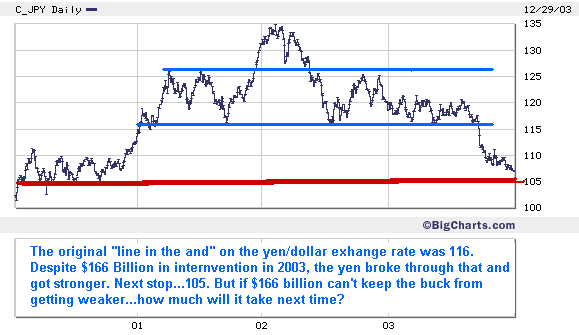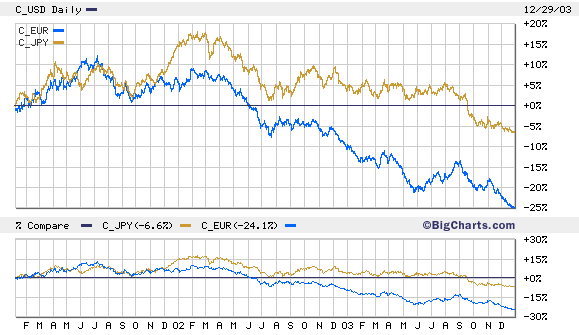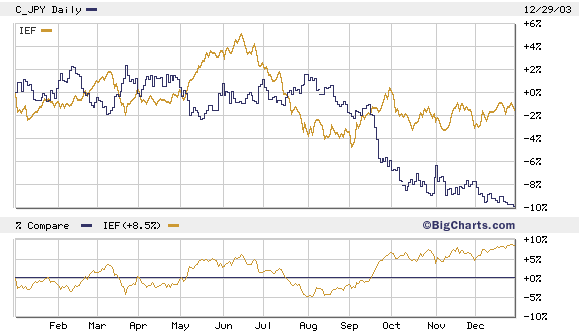Yellow Hope
You start working on a story...and you have no idea where it will take you. So it was Sunday night when I kept getting the question, " Won't Asian Central Bank buying of U.S. bonds (a) make your IEF puts a bad idea and (b) put a floor under the exchange value of the dollar? The question has to be tackled in two parts. First, does Japanese buying of U.S. bonds support bond prices. Second, to what extent does Japanese buying of U.S. bonds support the dollar itself? Let's take the bond price question first. The Japanese buy U.S. bonds in order to keep the yen weak relative the dollar--and keep Japanese exports cheap to U.S. buyers. In fact, just this week, the Japanese government said it spent 17.8 trillion yen (US$166.23 billion) on yen-selling operations in the first eleven months of 2003. And to what effect? Well, the yen did stabilize relative to the dollar, for awhile. But this is what central bankers like to call an "orderly retreat." Check out the chart below. A Disorderly Retreat
 So, now we know that yen intervention kind of worked, at least to keep the currency from getting too strong too fast. It certainly kept the yen from getting as strong as the euro, as the chart below shows.
So, now we know that yen intervention kind of worked, at least to keep the currency from getting too strong too fast. It certainly kept the yen from getting as strong as the euro, as the chart below shows.
 Of course, we also need to know if yen buying supported U.S. bond prices. That's the critical question for IEF. Indulge me in one more chart.
Of course, we also need to know if yen buying supported U.S. bond prices. That's the critical question for IEF. Indulge me in one more chart.
 The chart above compares the year-to-date performance of IEF and the yen. It's hard to draw a definite conclusion. But the key time on the chart is the August-September period. During that period, bond prices made a bottom--and the yen strengthened against the dollar (it's counterintuitive to say that the yen got "stronger" when its line on the chart is going down...but remember, that means it's taking fewer yen to buy one dollar. 100 yen for one dollar would be about where 'parity' is.)
According to this report from Mizuho bank, there were two occasions in September of this year that yen selling/dollar buying exceeded 1 trillion yen. The first was September 12th and the second was on September 30th. The first intervention at yen 116 to the dollar. The second came at 110. And neither worked very well.
What's interesting about those days is that one came before the G7 meeting and one came after. The G& meeting in Dubai which famously (as statements from central bankers go) called for "flexible exchange rates."
This was a not so subtle request that the Japanese quit selling yen and buying dollars and that maybe the Chinese should de-peg the yuan. The Japanese, having intervened to the tune of 1 trillion yen before the meeting, took some of the sting of the move they must have known was coming. Then, they put a new floor in at 105.
Yet not one jot or tittle of this has arrested the dollar's spectacular fall versus the euro. It's 19% this year, and a full 50% since the euro was at its nadir against dollar of .82 back in October of 2000.
It's clear now that a weak dollar isn't in ANYONE's interests (except, perhaps, any U.S. manufacturers that haven't already been put out of the business by the Chinese.) A weak dollar is certainly not in Europe's interest. Already the dollar is close to the 1.30 versus the euro level that Europeans have said would cause substantial "pain."
So will the green back firm up without the U.S. having to raise rates? Will the dollar find its level versus the euro and the Japan...and then, in the orderly fashion everyone expects, settle light on its feet and begin a graduated comeback?
Everyone would like to think so. But the problem is the same as it's ever been these last five years....debt. The whole point of flexible and open currency exchanges is that a currency can accurately reflect the health of the economy it comes from. And as much as everyone would LIKE the dollar to be stronger, the level of debt in the U.S. is the ugly, insistent reminder than the world cannot ride the back of U.S. consumers to economic salvation.
For instance, take U.S. Federal debt. It was $374 billion in FY 2003. It's already on pace to that exceed that and end up between $400 billion and $500 billion. Let's say $450. And let's say Japan and China continue buying up about 35% of the Treasury market.
That leaves nearly $300 billion in new U.S. debt to be scooped up by foreign governments and the public markets. Can that happen? Sure. It's new supply. But there seems to be a healthy appetite for U.S. debt. Let's say the world can swallow it. What does that leave?
Well...assuming everyone's dreams are realized...it leaves a HUGE current account deficit whereby U.S. consumers scoop up even cheaper Asian and European imports. That deficit--where Americans take up the cause of the world and consume more than they produce---threatens the value of the dollar. Only if the world continues to scoop up U.S. financial assets and own dollar-denominated assets does the dollar keep from buckling.
And so this is the bargain the world seems to be willing to make: own richly valued U.S. stocks and pray for two things. Pray first for a robust U.S. economic rebound that takes stocks even higher. Pray second that American consumer can keep up their spending pace--even if it means taking on more debt.
This seems like a bad bet to me, and a prayer not likely to be answered (anymore that my prayers about winning the lottery, dating Miss America, and pitching for the Orioles).
More likely, 2004 will see even more hedging against the dollar. Foreign Central Banks will add euros to their reserves. Perhaps even gold. Dollars will be sold, and certainly bought with less frequency than now. And eventually, U.S. interest rates will rise money gets tighter.
It's actually pretty astonishing it hasn't happened yet. But the debt, unlike the dreams, isn't going away any time soon. And all that debt makes America--the American consumer and his government--a bad credit risk.
The chart above compares the year-to-date performance of IEF and the yen. It's hard to draw a definite conclusion. But the key time on the chart is the August-September period. During that period, bond prices made a bottom--and the yen strengthened against the dollar (it's counterintuitive to say that the yen got "stronger" when its line on the chart is going down...but remember, that means it's taking fewer yen to buy one dollar. 100 yen for one dollar would be about where 'parity' is.)
According to this report from Mizuho bank, there were two occasions in September of this year that yen selling/dollar buying exceeded 1 trillion yen. The first was September 12th and the second was on September 30th. The first intervention at yen 116 to the dollar. The second came at 110. And neither worked very well.
What's interesting about those days is that one came before the G7 meeting and one came after. The G& meeting in Dubai which famously (as statements from central bankers go) called for "flexible exchange rates."
This was a not so subtle request that the Japanese quit selling yen and buying dollars and that maybe the Chinese should de-peg the yuan. The Japanese, having intervened to the tune of 1 trillion yen before the meeting, took some of the sting of the move they must have known was coming. Then, they put a new floor in at 105.
Yet not one jot or tittle of this has arrested the dollar's spectacular fall versus the euro. It's 19% this year, and a full 50% since the euro was at its nadir against dollar of .82 back in October of 2000.
It's clear now that a weak dollar isn't in ANYONE's interests (except, perhaps, any U.S. manufacturers that haven't already been put out of the business by the Chinese.) A weak dollar is certainly not in Europe's interest. Already the dollar is close to the 1.30 versus the euro level that Europeans have said would cause substantial "pain."
So will the green back firm up without the U.S. having to raise rates? Will the dollar find its level versus the euro and the Japan...and then, in the orderly fashion everyone expects, settle light on its feet and begin a graduated comeback?
Everyone would like to think so. But the problem is the same as it's ever been these last five years....debt. The whole point of flexible and open currency exchanges is that a currency can accurately reflect the health of the economy it comes from. And as much as everyone would LIKE the dollar to be stronger, the level of debt in the U.S. is the ugly, insistent reminder than the world cannot ride the back of U.S. consumers to economic salvation.
For instance, take U.S. Federal debt. It was $374 billion in FY 2003. It's already on pace to that exceed that and end up between $400 billion and $500 billion. Let's say $450. And let's say Japan and China continue buying up about 35% of the Treasury market.
That leaves nearly $300 billion in new U.S. debt to be scooped up by foreign governments and the public markets. Can that happen? Sure. It's new supply. But there seems to be a healthy appetite for U.S. debt. Let's say the world can swallow it. What does that leave?
Well...assuming everyone's dreams are realized...it leaves a HUGE current account deficit whereby U.S. consumers scoop up even cheaper Asian and European imports. That deficit--where Americans take up the cause of the world and consume more than they produce---threatens the value of the dollar. Only if the world continues to scoop up U.S. financial assets and own dollar-denominated assets does the dollar keep from buckling.
And so this is the bargain the world seems to be willing to make: own richly valued U.S. stocks and pray for two things. Pray first for a robust U.S. economic rebound that takes stocks even higher. Pray second that American consumer can keep up their spending pace--even if it means taking on more debt.
This seems like a bad bet to me, and a prayer not likely to be answered (anymore that my prayers about winning the lottery, dating Miss America, and pitching for the Orioles).
More likely, 2004 will see even more hedging against the dollar. Foreign Central Banks will add euros to their reserves. Perhaps even gold. Dollars will be sold, and certainly bought with less frequency than now. And eventually, U.S. interest rates will rise money gets tighter.
It's actually pretty astonishing it hasn't happened yet. But the debt, unlike the dreams, isn't going away any time soon. And all that debt makes America--the American consumer and his government--a bad credit risk.

0 Comments:
Post a Comment
<< Home